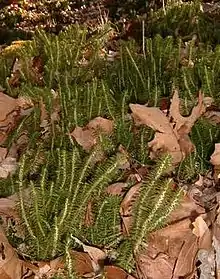Huperzia lucidula
Huperzia lucidula (also called the shining firmoss or shining clubmoss) is a bright, evergreen, rhizomatous clubmoss of the genus Huperzia.
| Shining firmoss | |
|---|---|
 | |
| Scientific classification | |
| Kingdom: | Plantae |
| Clade: | Tracheophytes |
| Clade: | Lycophytes |
| Class: | Lycopodiopsida |
| Order: | Lycopodiales |
| Family: | Lycopodiaceae |
| Genus: | Huperzia |
| Species: | H. lucidula |
| Binomial name | |
| Huperzia lucidula (Michaux) Trevisan | |
| Synonyms | |
|
Lycopodium lucidulum Michx. | |
They grow in loose tufts 14–20 cm long, occasionally up to 1 m long. The leaves are 7–11 mm long (shorter, 3–6 mm, at annual nodes) and narrow, lance-shaped, shiny, and evergreen. The edges are irregularly “toothed” with small serrations. The sporangia (spore cases) are nestled in the bases of the upper leaves. The roots of this plant grow from a creeping and branching underground rhizome.
The shining firmoss is found in Canada from Manitoba in the west and east to Newfoundland; south into the United States, along the Eastern Seaboard to South Carolina, and west through to Missouri. Its preferred habitat is mainly rich, acidic soils in cool, moist coniferous or mixed hardwood forests, as well as near bogs, above stream banks, and on sheltered, low hillsides. They occasionally grow on moss-lined cliffs and ledges, or on shaded, acidic sandstone outcroppings.
The specific name lucidula comes from Latin and means "shining". This is in clear reference to the plant’s bright, vivid green color.
Reproduction is either by copious spore production from sporangia (at the base of stem leaves) or vegetatively through the spread of gemmae.[1]
References
- "Ferns and Fern Allies of Wisconsin". University of Wisconsin. Retrieved 8 March 2022.
 A specimen from North Carolina
A specimen from North Carolina
